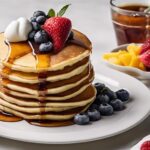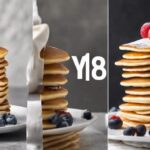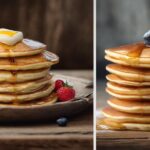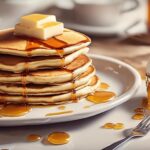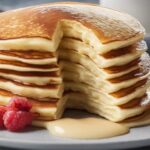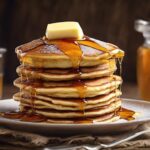Raw Food Ingredients
Pancake Vs Hotcake: Spotting the Differences
Analyze the subtle distinctions between pancakes and hotcakes, uncovering surprising variations that will change your breakfast game forever.
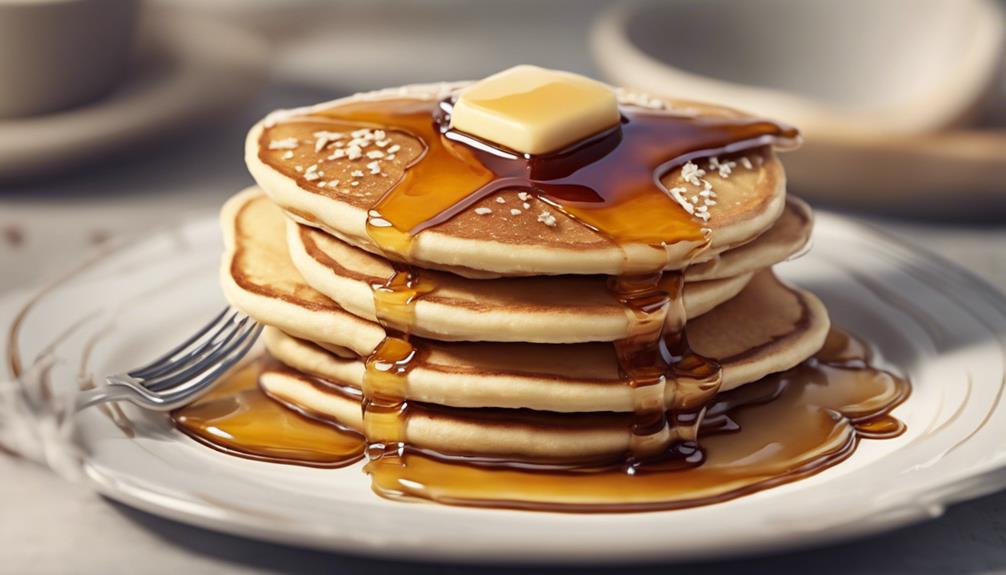
When comparing pancakes and hotcakes, distinct differences can be observed in their size, thickness, ingredients, cooking methods, and cultural significance. American pancakes are wide and fluffy, providing a delicate and airy experience, while hotcakes are thicker and denser, offering a heartier and more filling option. Pancakes typically use all-purpose flour, eggs, milk, and butter, while hotcakes may contain more eggs and a blend of cake flour and all-purpose flour. Cooking pancakes on a frying pan over medium heat and hotcakes on a griddle at slightly lower heat are essential distinctions. Popular toppings for both include maple syrup, fruit compote, and bacon.
Moreover, understanding the historical and regional variations sheds light on these beloved breakfast choices.
Key Takeaways
- American pancakes are wide and fluffy, while hotcakes are thicker and denser.
- Pancakes use all-purpose flour, eggs, milk, and butter; hotcakes may have more eggs and a mix of cake flour and all-purpose flour.
- Pancakes are cooked on a frying pan over medium heat, while hotcakes are cooked on a griddle at slightly lower heat.
- Waiting for bubbles before flipping is crucial for pancakes, while hotcakes are cooked slowly for a fluffy texture.
- Both pancakes and hotcakes offer a delightful breakfast experience with variations in size, thickness, and texture.
Key Differences in Size and Thickness
When comparing pancakes and hotcakes, one can immediately notice the key differences in size and thickness. American pancakes, known for their wide and fluffy nature, tend to be thinner compared to hotcakes. These pancakes are perfect for those who enjoy a lighter texture in their breakfast treat.
On the other hand, hotcakes, while still delicious, can be thicker and denser, offering a more substantial bite. The size and thickness variations between the two can greatly impact your taste and texture preferences.
For those who prefer a more delicate and airy pancake experience, American pancakes are the ideal choice. Their thinner profile allows for a quicker cooking time and a softer texture. However, if you crave a heartier and more filling option, hotcakes might be the way to go. Their thickness provides a satisfying mouthfeel that can be quite comforting.
Ultimately, whether you lean towards American pancakes or hotcakes, both offer a delightful breakfast experience tailored to your personal preferences.
Texture Variations to Look For
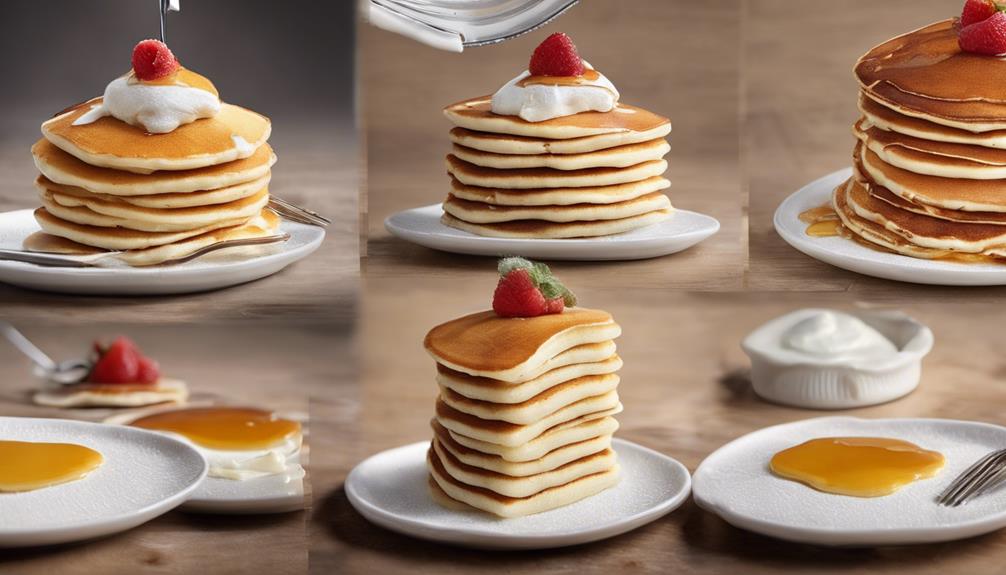
Texture variations between pancakes and hotcakes can be easily discerned by noting their differences in thickness and density. Hotcakes, as mentioned in the facts, are often thicker and denser compared to traditional pancakes. This means that when you take a bite into a hotcake, you might notice a more compact texture compared to the wider and fluffier texture of a pancake.
The thickness of these breakfast treats can also impact how they cook and the overall mouthfeel when you eat them. Hotcakes may offer a slightly different experience due to their denser nature, providing a unique texture that sets them apart from pancakes.
While the variations in texture between pancakes and hotcakes might be subtle, paying attention to these differences can make your breakfast experience more enjoyable and help you appreciate the distinct qualities that hotcakes bring to the table.
Ingredients Distinctions Between Pancakes and Hotcakes
Pancakes and hotcakes differ in their ingredients. Pancakes are commonly made from flour, eggs, milk, and butter, while hotcakes may have a higher egg content resulting in a lighter texture. Understanding these distinctions can help distinguish between the two breakfast favorites.
Keep an eye out for differences in flour types used and leavening agent preferences when comparing pancakes and hotcakes.
Flour Types Used
In crafting hotcakes, a blend of cake flour and all-purpose flour is often utilized to achieve a lighter texture compared to the traditional all-purpose flour used in pancakes. Cake flour, with its lower protein content, helps create a tender crumb and a softer bite in hotcakes.
On the other hand, the higher protein content in all-purpose flour, commonly used in pancakes, results in a chewier texture and a more substantial bite. The choice of flour type plays an essential role in determining the final texture and taste of both pancakes and hotcakes.
Experimenting with different flour combinations can lead to variations in the overall mouthfeel and consistency of these beloved breakfast treats.
Leavening Agent Preference
When crafting pancakes and hotcakes, the choice of leavening agent greatly influences their fluffiness and texture.
- Pancakes typically use baking powder for fluffiness.
- Hotcakes often rely on baking soda, creating a slightly different texture.
- Baking powder reacts with liquid and heat in pancakes.
- Baking soda requires an acid for activation in hotcakes.
- The leavening agent choice affects the rise and texture of the final product.
Understanding these differences can help distinguish between pancakes and hotcakes.
Cooking Methods Comparison
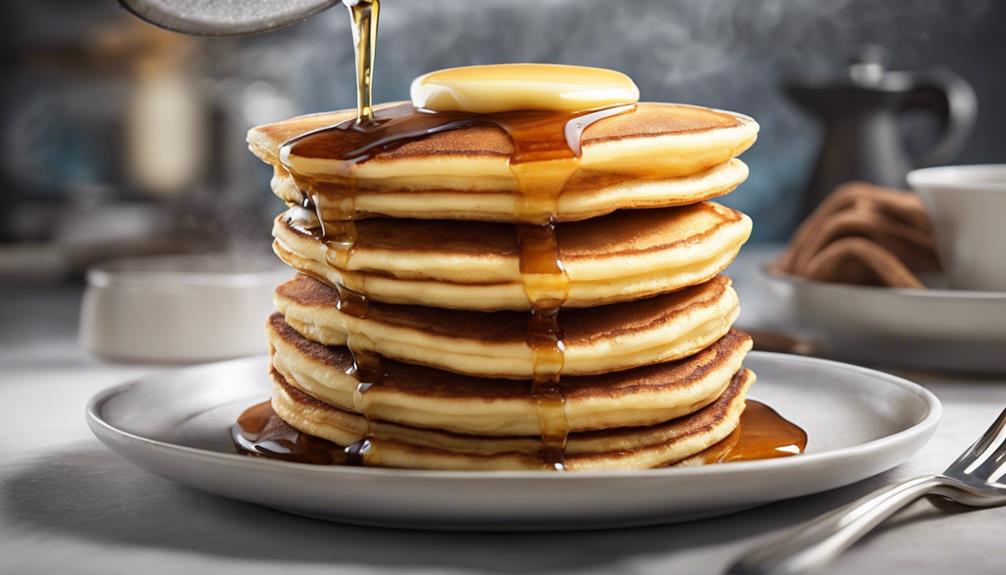
For achieving optimal results, it's advisable to cook these breakfast treats on a non-stick surface at specific temperatures. Pancakes are usually cooked on a frying pan over medium heat, while hotcakes are often prepared on a griddle or skillet at a slightly lower heat.
When cooking pancakes, wait to flip them until bubbles appear on the surface and the edges look set. On the other hand, hotcakes are cooked slowly to guarantee even cooking and a fluffy texture.
Both pancakes and hotcakes require a non-stick cooking surface to prevent sticking and guarantee a golden-brown finish. It's crucial to pay attention to the heat level to achieve the perfect texture and color.
Toppings and Sides Preference
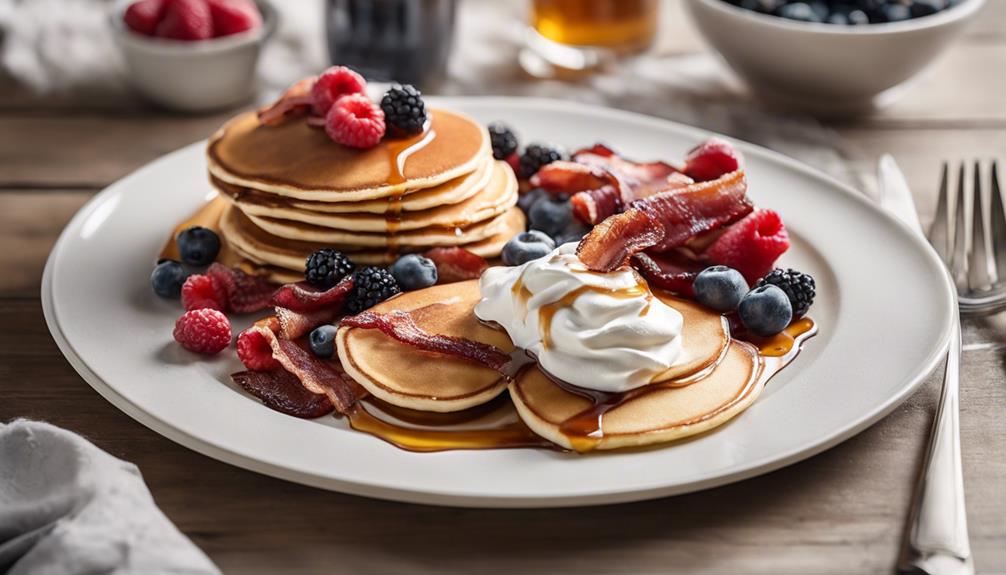
After mastering the cooking methods for pancakes and hotcakes, exploring diverse toppings and sides can elevate the breakfast experience to new heights. When it comes to topping your pancake, the options are endless. From classic choices like maple syrup and fruit compote to indulgent treats like whipped cream and chocolate chips, each topping adds its unique flavor to the dish. For a more savory twist, sides like crispy bacon, eggs, and sausage complement the sweetness of the pancake perfectly, creating a balanced meal that satisfies all taste preferences.
- Maple Syrup: A classic pancake topping that adds a sweet and rich flavor.
- Fruit Compote: Fresh fruits cooked down into a sweet sauce that pairs wonderfully with pancakes.
- Whipped Cream: Light and airy, whipped cream adds a decadent touch to your pancake.
- Bacon: Crispy and savory bacon is a popular side choice to balance the sweetness of pancakes.
- Greek Yogurt: A healthier topping option that provides a creamy texture and a tangy flavor to your pancake.
Regional Variations in Naming and Preparation
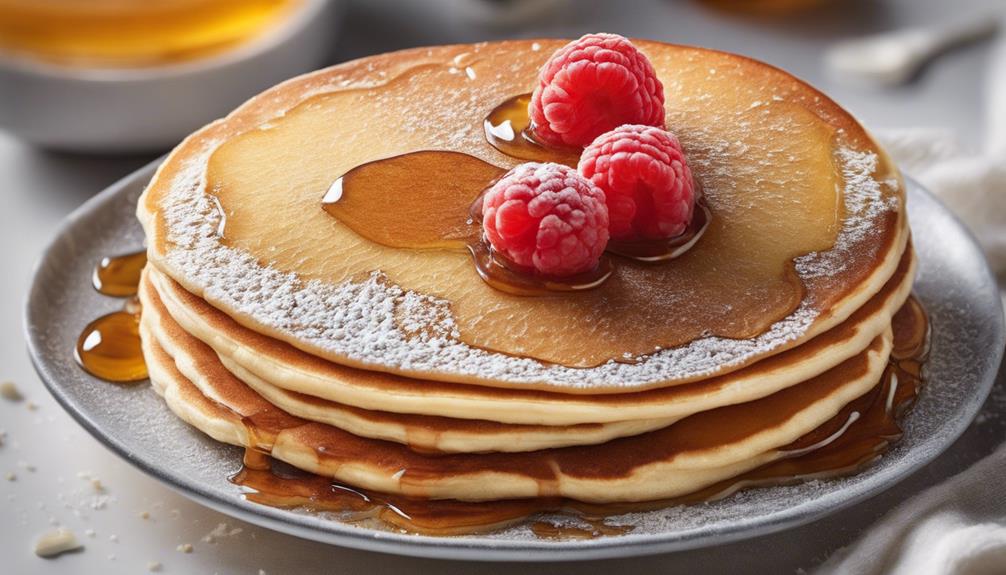
In various parts of the world, pancakes can go by different names, such as flapjacks, griddle cakes, or batter cakes.
Different regions also have unique ways of preparing these delicious treats, from the ingredients used to the cooking methods employed.
Exploring these regional variations in naming and preparation can offer a deeper understanding of the diverse culinary traditions surrounding this beloved dish.
Name Differences
Pancakes, known by various names globally, exhibit diverse regional variations in both naming conventions and preparation methods.
- Flapjacks, pancakes, and hotcakes are often interchangeable names for the same dish in the US.
- Regional variations in the US lead to unique names for pancakes, such as griddle cakes and batter cakes.
In the UK, flapjacks are distinct from pancakes and are made from rolled oats and brown sugar.
Other global names for pancakes include blintzes, blinis, and slapjacks, reflecting cultural diversity.
The naming of pancakes can vary by region, showcasing the rich culinary traditions associated with this popular dish.
Cooking Methods
Exploring the various cooking methods used regionally can provide insights into the differences in texture and thickness between pancakes and hotcakes. In Japan, for example, a popular variation known as Japanese hotcakes are made using a unique technique. Japanese hotcakes are typically fluffier and thicker than traditional pancakes due to the inclusion of whipped egg whites in the batter. This method creates a lighter texture that sets Japanese hotcakes apart from their American counterparts.
Ingredient Variations
When examining the diverse world of pancake variations, one quickly realizes that ingredient variations play an important role in distinguishing regional naming and preparation methods.
- Some regions use cornmeal or buckwheat flour for a heartier texture.
- Buttermilk is a popular choice in the Southern US for a tangy flavor.
- In Japan, fluffy pancakes are made with meringue for a light and airy texture.
- Indonesian pancakes, known as Martabak, incorporate sweet fillings like chocolate and cheese.
- Swedish pancakes are thinner than American ones and often served with lingonberry jam.
Understanding these ingredient variations can provide insight into the diverse and delicious world of pancakes around the globe.
Historical Origins of Pancakes and Hotcakes
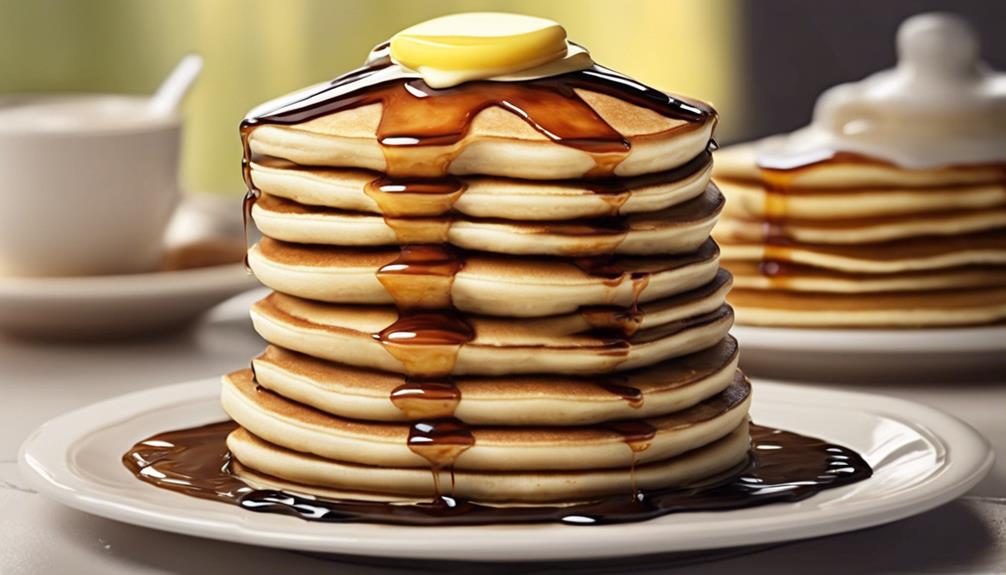
Having been enjoyed for centuries, the historical origins of pancakes and hotcakes trace back to early versions likely made by prehistoric ancestors. Stone Age cooks might have baked thin pancakes on hot rocks, showcasing the long history and global presence of this beloved dish. While the exact origins are challenging to pinpoint, pancakes have remained a staple in various cultures for thousands of years. These thin, flat cakes cooked in a pan are part of the same griddle cake family, known by different names across regions and featuring unique variations in thickness and texture.
| Historical Origins of Pancakes and Hotcakes | |
|---|---|
| Timeline | Significance |
| Prehistoric Era | Likely made by early ancestors |
| Stone Age | Baking thin pancakes on hot rocks |
| Throughout History | Staple in various cultures |
The evolution of pancakes and hotcakes showcases the enduring appeal of these delicious treats, connecting us through time and culture.
Popular Varieties and Recipes to Try
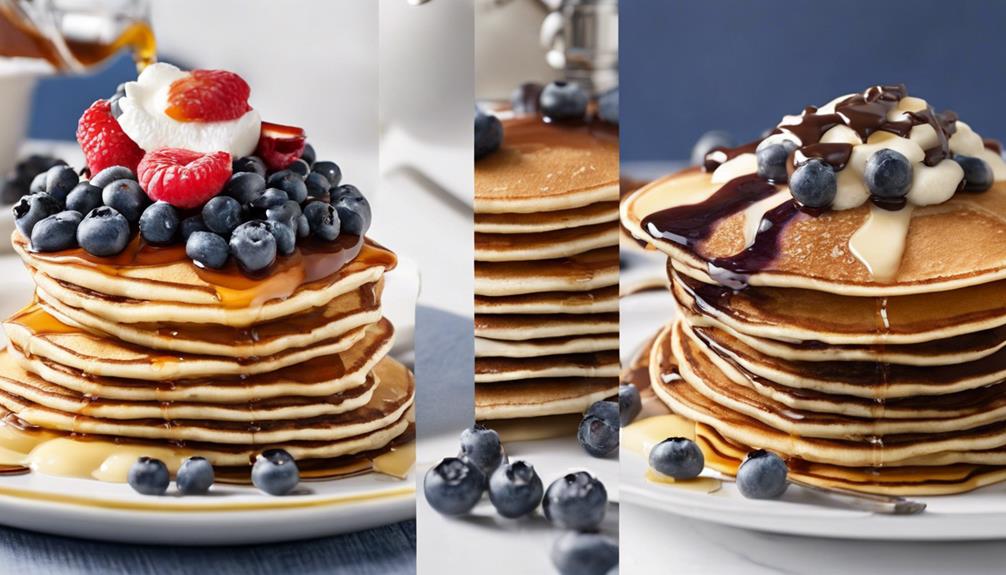
Let's explore the diverse array of popular pancake and hotcake varieties, each offering unique flavors and textures to tantalize your taste buds.
- Japanese Hotcakes: These are known for their thickness and fluffiness, achieved by beating the batter until foamy.
- UK Pancakes: In the UK, these are often referred to as griddle cakes or batter cakes.
- Global Varieties: Unique names for pancakes worldwide include blintzes, blinis, and slapjacks.
- Denser Hotcakes: Hotcakes can be denser and thicker compared to traditional pancakes, providing a different texture experience.
- Crepes: Another type of pancake, crepes are thin and versatile, often served with various sweet or savory fillings.
When trying these delectable treats, don't forget to drizzle some maple syrup over your pancakes or hotcakes for that perfect touch of sweetness.
Enjoy the variety of flavors and textures these pancakes and hotcakes offer, and get creative with your toppings and fillings to make each bite a delightful experience.
Frequently Asked Questions
What Is the Difference Between a Pancake and a Hotcake?
I see the difference between a pancake and a hotcake lies in their thickness and texture. Hotcakes tend to be thicker and denser compared to fluffy pancakes. The term 'hotcake' may be used in marketing or to describe a specific style of pancake.
Why Are They Called Hotcakes Instead of Pancakes?
Well, they're called hotcakes instead of pancakes because the term "hotcakes" sizzles with excitement, evoking images of steaming, delicious treats flying off the griddle. It's all about that irresistible appeal.
Who Calls Pancakes Hotcakes?
I call pancakes hotcakes. It's a regional preference that adds a cozy touch. The term 'hotcakes' often pops up in eateries and ads, making them sound even more tempting. Who can resist hot, fluffy hotcakes on a lazy morning?
What's the Difference Between Cakes and Pancakes?
When comparing cakes to pancakes, the key differences lie in their cooking methods and textures. Cakes are baked in the oven and tend to be thicker, while pancakes are fried on a griddle, resulting in a thin, flat texture.
– Are there any significant differences between Pancakes and Hotcakes that I should be aware of?
When it comes to pancakes and hotcakes, the differences are minimal. However, the main distinction lies in the texture and thickness. Pancakes are lighter and thinner, while hotcakes are thicker and fluffier. Other than that, the pound cake ingredients compared are quite similar, with both using flour, eggs, milk, and butter.
Conclusion
To sum up, when it comes to the debate between pancakes and hotcakes, the key differences lie in size, texture, ingredients, cooking methods, toppings, and regional variations.
Whether you prefer fluffy pancakes or dense hotcakes, there's a variety of options to choose from. Experiment with different recipes to find your favorite, and don't forget to try out various toppings and sides to enhance the flavor.
Happy pancake or hotcake eating!
Rachael, the Editor in Chief of RachaelsRawFood.com, is an inspiring and passionate individual who has dedicated her life to promoting the benefits of a raw food lifestyle. Known for her vibrant and energetic personality, Rachael has built a strong online presence that has transformed her personal journey into a thriving community of raw food enthusiasts.
Raw Food Ingredients
How Much Caffeine in Cocoa?
Not all cocoa products are created equal when it comes to caffeine content – discover which one might surprise you!

When evaluating the caffeine levels in cocoa, it’s important to recognize that dark chocolate contains around 43 mg of caffeine per 100 grams due to its high cocoa solid content. Dark chocolate has a higher caffeine content compared to milk or white chocolate. This means that consuming dark chocolate in moderation can assist in managing your caffeine intake. On the other hand, milk chocolate has around 20 mg of caffeine per 100 grams while white chocolate is caffeine-free. Cocoa powder, commonly used in baking and beverages, contains a substantial 230 mg of caffeine per 100 grams. Being aware of these distinctions in chocolates can help you make informed decisions about your caffeine consumption.
Key Takeaways
- Caffeine content in cocoa varies based on cocoa solid concentrations.
- Unsweetened cocoa powder can contain around 230 mg of caffeine per 100 grams.
- Roasting cocoa solids influences the final caffeine content in cocoa products.
- Dark chocolate, with high cocoa solid content, has more caffeine than milk chocolate.
- Moderate consumption of cocoa products helps manage caffeine intake.
Caffeine Content in Dark Chocolate
Dark chocolate boasts a caffeine content of approximately 43 mg per 100 grams, mainly deriving from its higher cocoa solid composition. When we indulge in this decadent treat, we aren't only savoring its rich cocoa flavor but also a subtle caffeine kick. Compared to milk or white chocolate, dark chocolate contains a higher amount of caffeine.
Please bear in mind that moderate consumption of dark chocolate can assist individuals in managing their caffeine intake effectively. The caffeine levels in dark chocolate are about one-fourth of what you'd find in a standard cup of coffee. So, if you're looking for a milder caffeine boost, a piece of dark chocolate might just do the trick without the jitters that sometimes accompany a strong cup of coffee.
Enjoy your dark chocolate in moderation, savoring both its taste and the gentle pick-me-up it provides.
Caffeine Levels in Milk Chocolate

Milk chocolate, known for its creamy texture and sweet flavor, contains a modest caffeine content of approximately 5.6 mg per ounce, as indicated by USDA data. Unlike dark chocolate, milk chocolate has a lighter color due to lower cocoa content, resulting in reduced caffeine levels.
The delightful creamy taste in milk chocolate comes from a harmonious blend of cocoa and milk powder. While dark chocolate boasts higher caffeine content, milk chocolate remains a popular choice for those seeking a sweet treat with minimal caffeine intake.
Caffeine Presence in White Chocolate
With its unique composition excluding cocoa solids, white chocolate stands out as a caffeine-free alternative to its darker counterparts. White chocolate is crafted from a blend of cocoa butter, milk powder, sugar, and vanilla, making it a delectable treat without the stimulating effects of caffeine. For individuals sensitive to caffeine, white chocolate offers a creamy texture and indulgent flavor without the worry of unwanted side effects. This makes it a popular choice for desserts among those looking to steer clear of caffeine in their sweet treats.
Compared to dark chocolate, which contains cocoa solids and hence caffeine, white chocolate provides a caffeine-free option for those seeking a more mellow indulgence. So, if you're in the mood for a luscious and smooth chocolate experience without the buzz of caffeine, white chocolate is the perfect choice for your next dessert delight.
Impact of Cocoa Solids on Caffeine

In determining the caffeine levels in cocoa products, the percentage of cocoa solids plays a significant role. Here are some key points about the impact of cocoa solids on caffeine content:
- Caffeine Derivation: The caffeine content in cocoa primarily comes from cocoa solids, making it an important factor in determining the overall caffeine levels in cocoa-based products.
- Dark Chocolate: Dark chocolate, known for its higher cocoa solid content, tends to contain more caffeine compared to milk or white chocolate varieties due to this higher concentration.
- Unsweetened Cocoa Powder: A 100g serving of unsweetened cocoa powder can contain around 230mg of caffeine, reflecting the impact of the high cocoa solid content in this form.
- Health Benefits: The roasting process of cocoa solids not only affects the flavor profile but also influences the caffeine content, contributing to the potential health benefits associated with consuming cocoa products like hot cocoa.
Comparing Caffeine in Different Chocolates
Comparing the caffeine content in different chocolates reveals varying levels based on their cocoa solid concentrations. Dark chocolate contains about 43 mg of caffeine per 100 grams, making it a stronger caffeinated option compared to milk chocolate, which only has around 20 mg per 100 grams.
Surprisingly, white chocolate, derived from cocoa butter, doesn't contain any caffeine at all. For those seeking a more potent caffeine kick, cocoa powder is the way to go, boasting a high concentration of 230 mg per 100 grams.
The amount of caffeine in chocolate products is closely linked to the cocoa solid content, with dark chocolate containing the highest levels. So, the next time you're craving a chocolate treat but also need a little energy boost, opt for dark chocolate to get the most caffeine per bite.
Frequently Asked Questions
Is There More Caffeine in Cocoa Than Coffee?
There's more caffeine in cocoa than in coffee. Cocoa powder packs 230 mg per 100 grams, surpassing most coffee varieties. Dark chocolate has even more caffeine due to higher cocoa content. It's a rich, unique energy source.
Is There a Lot of Caffeine in Hot Cocoa?
There isn't a lot of caffeine in hot cocoa. It depends on the brand and recipe. Starbucks hot chocolate has around 25 mg per serving, while basic mixes have about 5 mg. The amount of cocoa powder used influences the caffeine content.
Is There Caffeine in Hershey's Cocoa?
Absolutely, Hershey's Cocoa does contain caffeine, but it's not overwhelming. It adds a delightful hint of energy in each spoonful. Perfect for baking or a cozy cup of hot chocolate. Just the right amount!
Is Cocoa a Stimulant Like Caffeine?
Cocoa stimulates like caffeine due to its theobromine content. Decaf versions offer a solution for caffeine-sensitive folks. Options include regular cocoa with caffeine, Dutch-processed cocoa with less, and decaf cocoa with reduced caffeine while keeping healthful compounds.
What are the potential health effects of consuming high levels of caffeine in cocoa?
Unveiling cocoa caffeine levels can lead to potential health effects of excessive consumption. High levels of caffeine in cocoa may contribute to insomnia, nervousness, and fast heartbeat. It can also cause gastrointestinal discomfort and exacerbate anxiety disorders. Moderation in consuming caffeinated cocoa products is recommended for overall health.
Conclusion
To sum up, the caffeine content in cocoa varies depending on the type of chocolate. Dark chocolate typically has the highest caffeine levels, followed by milk chocolate and white chocolate. The amount of cocoa solids in the chocolate also affects the caffeine content.
Remember, just like different chocolates have different levels of caffeine, we all have unique strengths and abilities. Embrace your individuality and always aim for balance in everything you do.
Rachael, the Editor in Chief of RachaelsRawFood.com, is an inspiring and passionate individual who has dedicated her life to promoting the benefits of a raw food lifestyle. Known for her vibrant and energetic personality, Rachael has built a strong online presence that has transformed her personal journey into a thriving community of raw food enthusiasts.
Raw Food Ingredients
5 Key Differences: Caffeine Content in Cocoa Vs Coffee
Open the door to understanding the contrasting caffeine levels in cocoa and coffee, revealing surprising insights that will reshape your beverage choices.

When comparing the caffeine levels in cocoa and coffee, it is important to understand that cocoa generally has lower caffeine content than coffee. Dark chocolate contains approximately 12 milligrams of caffeine per ounce, while hot cocoa typically ranges from 5 to 10 milligrams per ounce. In contrast, brewed coffee can have significantly higher levels, varying from 95 to 165 milligrams per 8-ounce cup.
Cocoa is considered a milder option for individuals aiming to limit their caffeine intake, with theobromine providing a gradual energy increase. Meanwhile, coffee's caffeine content offers immediate alertness, and understanding these distinctions can help you select based on your preferred effects.
Key Takeaways
- Cocoa contains lower caffeine levels but compensates with theobromine for a gradual energy increase.
- Coffee has higher caffeine content, offering an immediate alertness boost and potentially higher metabolic rate.
- Theobromine in cocoa promotes relaxation, while caffeine in coffee provides intense alertness and mood fluctuations.
- Hot chocolate is a good option for reducing caffeine intake while still benefiting from theobromine effects.
- Understanding caffeine variances helps make informed choices for desired energy levels and mood effects.
Caffeine Levels in Cocoa Vs Coffee
When comparing caffeine levels in cocoa versus coffee, it's evident that cocoa generally contains lower amounts per serving. Dark chocolate, made from cacao beans, contains around 12 milligrams of caffeine per ounce, while a 1-ounce serving of hot cocoa mix typically has 5-10 milligrams. Even a 16-ounce serving of Starbucks hot chocolate only contains about 25 milligrams of caffeine.
On the other hand, coffee, when brewed, can range from 95 to 165 milligrams of caffeine per 8-ounce cup, depending on the type and brewing method. This significant difference in caffeine content between cocoa and coffee makes cocoa a milder option for those looking to limit their caffeine intake.
Impact on Alertness and Energy

Typically, the immediate alertness and energy boost from caffeine in coffee can last for hours. This surge in alertness is due to caffeine's stimulating effect on the central nervous system. On the other hand, cocoa contains theobromine, which provides a more gradual increase in energy levels. Unlike caffeine, theobromine doesn't cause sudden spikes and crashes, offering a smoother energy curve.
Coffee's caffeine content can temporarily boost the metabolic rate, potentially supporting weight management efforts. This increased metabolic rate can aid in burning calories and may contribute to weight loss when combined with a balanced diet and regular exercise. Additionally, theobromine in cocoa contributes to the thermogenic effect, leading to mild calorie burning in the body.
Both caffeine and theobromine can influence mood. Caffeine tends to provide a more intense and quick-acting mood elevation, while theobromine promotes feelings of relaxation and contentment. Understanding the differences in alertness, energy, metabolic effects, and mood enhancements between cocoa and coffee can help individuals make informed choices based on their preferences and wellness goals.
Metabolic Variances and Effects
Regarding metabolic variances and effects, the varying caffeine levels between cocoa and coffee play a significant role. When comparing the metabolic impact of caffeine in cocoa and coffee, it is crucial to note that cocoa contains lower levels of caffeine but compensates with theobromine, which aids in the thermogenic effect, promoting calorie burning and metabolic activity. On the other hand, coffee, especially brewed varieties, contains higher levels of caffeine, potentially providing a temporary boost to the metabolic rate, which could assist in weight management. While caffeine in coffee offers a quick energy surge, theobromine in cocoa leads to a more gradual rise in energy levels, avoiding sudden spikes and crashes. To summarize the metabolic differences, I've created a table below:
| Aspect | Cocoa | Coffee |
|---|---|---|
| Caffeine Content | Lower levels | Higher levels |
| Additional Component | Theobromine | Caffeine |
| Metabolic Impact | Thermogenic effect | Temporary metabolic rate boost |
| Energy Levels | Gradual rise | Quick surge |
| Weight Management | Aids in calorie burning | Potential assistance |
Mood Enhancement Disparities

In comparing the mood enhancement effects of theobromine in cocoa and caffeine in coffee, notable disparities emerge in their impact on mental well-being.
The theobromine found in cocoa promotes relaxation and contentment, offering a gradual rise in energy levels that leads to a gentle and long-lasting mood enhancement experience.
On the other hand, caffeine delivers an intense and fast-acting boost in alertness, providing immediate energy levels that can lead to abrupt spikes and crashes.
While both theobromine and caffeine uplift mood, theobromine's effects are characterized by a steady and gradual increase in energy levels, creating a sense of calm and contentment.
In contrast, caffeine's impact is more intense and temporary, resulting in rapid alertness but also the potential for fluctuations in mood. Understanding these differences can help individuals choose between cocoa and coffee based on their desired mood enhancement effects.
Health Implications and Considerations
Health implications and considerations surrounding caffeine consumption warrant close attention due to its potential impact on various aspects of well-being. When comparing a cup of coffee to hot chocolate, it's vital to note the amount of caffeine present.
While coffee contains much caffeine, hot chocolate has less caffeine but isn't entirely devoid of it. The main active ingredients in hot chocolate are theobromine and caffeine, where theobromine is a relative of caffeine and also has stimulant effects, although milder. If you're looking to reduce your caffeine intake, opting for hot chocolate over a cup of coffee can be a good choice.
Being mindful of the caffeine content in chocolate products is important, especially if you're sensitive to caffeine or belong to vulnerable populations like children or pregnant women. Understanding the caffeine levels in different beverages allows you to make informed decisions about your consumption for better overall health.
Frequently Asked Questions
Is There Caffeine in Coffee Vs Cacao Powder?
Yes, there is caffeine in coffee, with around 140 milligrams in a 12-ounce cup. On the other hand, cacao powder contains only about 12 milligrams per tablespoon, making it a great caffeine-free alternative for those seeking a milder boost.
What Is the Difference Between Cocoa and Coffee?
When comparing cocoa and coffee, cocoa offers a rich, chocolatey flavor and is packed with antioxidants and minerals. Coffee, on the other hand, provides a robust, bitter taste and a jolt of caffeine for that morning pick-me-up.
Why Is Cocoa Better Than Coffee?
I believe cocoa is superior to coffee because it offers a gentler energy boost, promotes relaxation and contentment, and provides sustained vitality without sudden crashes. Plus, dark chocolate's theobromine supports cellular health and tastes delicious.
How Much Caffeine Is in Cocoa Powder Vs Decaf Coffee?
In cocoa powder vs decaf coffee, cocoa has 12-26mg of caffeine per tbsp, while decaf coffee holds 2-5mg per 8-ounce cup. The choice hinges on desired caffeine levels and flavor. I prefer cocoa's lower caffeine content.
How does the caffeine content in hot chocolate compare to coffee?
Hot chocolate caffeine content is significantly lower than that of coffee. While an 8-ounce cup of hot chocolate contains about 5-10 milligrams of caffeine, the same size of coffee can have anywhere from 95-200 milligrams. It’s a notable difference for those looking to limit their caffeine intake.
Conclusion
To sum up, while cocoa and coffee both contain caffeine, the levels vary significantly. Cocoa generally has lower caffeine content compared to coffee, impacting alertness, energy levels, and mood enhancement differently.
It's crucial to keep these differences in mind when choosing between the two beverages for your daily consumption. Remember, moderation is key to maintaining a healthy balance in your caffeine intake.
So, whether you prefer a cup of cocoa or a mug of coffee, enjoy it in moderation for the best benefits!
Rachael, the Editor in Chief of RachaelsRawFood.com, is an inspiring and passionate individual who has dedicated her life to promoting the benefits of a raw food lifestyle. Known for her vibrant and energetic personality, Rachael has built a strong online presence that has transformed her personal journey into a thriving community of raw food enthusiasts.
Raw Food Ingredients
A Guide to Becoming a Good King
Kingship demands wisdom, fairness, integrity, courage, and humility – essential traits for a successful reign and prosperous kingdom." Keep reading to uncover the secrets of becoming a good king.

In order to be a good king, one must embody wisdom, fairness, integrity, courage, and humility to lead the kingdom with honor. Wisdom is essential for making important decisions, fairness ensures just treatment for all, integrity builds trust and respect, courage is crucial for facing challenges, and humility reminds us of our humanity. Historical kings such as Solomon, Arthur, David, Charlemagne, and Ramses II serve as role models for these leadership traits.
As a king, embracing challenges, understanding the world, seeking personal growth, and learning from the past are essential responsibilities. Developing leadership skills, making wise decisions, and prioritizing the well-being of the people are key to effective kingship. Every step on the path to becoming a good king is critical for a successful reign and prosperous kingdom.
Key Takeaways
- Embrace wisdom for informed decisions.
- Practice fairness for just treatment.
- Uphold integrity to earn trust.
- Show courage in facing challenges.
- Maintain humility for empathy and respect.
Qualities of a Good King
Being a good king requires embodying qualities such as wisdom, fairness, integrity, courage, humility, and compassion in decision-making and leadership. Power comes with responsibility, and as a king, it's essential to wield this power wisely. Wisdom is vital in making sound judgments that benefit the kingdom as a whole. Fairness guarantees that all subjects are treated justly and equitably, fostering a harmonious society. Integrity is the foundation of trust and respect, key elements in effective leadership.
Courage is necessary to face challenges and make difficult decisions, even when met with opposition. Humility reminds a king of his humanity and the importance of humility in interactions with all subjects. Compassion demonstrates a king's care and empathy towards his people, fostering a sense of unity and loyalty. Effective communication is crucial for conveying decisions, listening to concerns, and inspiring confidence in leadership.
Historical Kings as Role Models

King Solomon, renowned for his wisdom and leadership, stands as an exemplar among historical kings who serve as role models for future leaders. Looking at figures like King Arthur, known for his justice and valor in medieval legends, and King David, celebrated for his faith and courage in battle, we find lessons that transcend time. Charlemagne's legacy of military conquests and cultural revival, alongside Ramses II's grand building projects and military campaigns, offer diverse insights into effective kingship. Below is a table summarizing key attributes of these historical kings:
| King | Attributes |
|---|---|
| King Solomon | Wisdom, leadership |
| King Arthur | Justice, valor |
| King David | Faith, courage |
| Charlemagne | Military prowess, culture revival |
| Ramses II | Building projects, military campaigns |
Studying these historical figures can provide valuable lessons on the multifaceted qualities that make a great ruler.
Responsibilities of Kingship
Embracing challenges and living authentically are central to fulfilling the responsibilities inherent in kingship. As men aspiring to be good kings, it's essential for us to understand that the world requires leaders who are kind, humble, and committed to personal growth.
The journey to becoming a good king involves more than just wielding power and responsibility—it entails sacrificing comfort for growth and transformation. Seeking the ancient path of masculinity, as exemplified by figures like Morgan, teaches us the importance of humility, vulnerability, and character development.
In fulfilling the responsibilities of kingship, we're entrusted with power not for our own gain, but for the betterment of the world around us. Just as seeds need Good Soil to flourish, we must nurture our own growth to lead effectively.
Leadership Skills for Kings

Developing essential leadership skills is crucial for aspiring kings seeking to fulfill their responsibilities with humility, vulnerability, and a focus on character development. As you study the world around us, the power and responsibility of what kingship entails become clearer. Here are some key points to think about on your path to becoming a king:
- Embrace challenges and live authentically.
- Seek ancient paths of masculinity for guidance.
- Reflect on your identity, purpose, and ability to be entrusted with power for good.
- Sacrifice comfort for growth, transformation, and participation in universal creativity.
The journey of becoming a king isn't just about gaining authority but about understanding the remarkable fellowship of like-hearted individuals who share similar goals. Engage in group discussion questions, consider between-session personal study, and explore the depths of your masculine soul. This is the path to restoring what it means to be a true king.
Importance of Wise Decision-Making
Steering through the intricacies of leadership, especially in the domain of kingship, requires a sharp focus on the art of prudent decision-making. Wise decision-making is like the compass guiding the ship of leadership towards success.
Good kings understand that their choices impact not just themselves but also the lives of those they rule over. They prioritize the well-being of their people over personal gains, embodying the essence of true leadership.
Seeking counsel from trusted advisors and reflecting on core values are essential practices in the domain of wise decision-making. By embracing humility and self-awareness, kings can navigate the complex web of choices with clarity and integrity.
Just like a six-session video Bible study can guide individuals in restoring the heart, wise decision-making is essential for becoming the kind of leaders our world needs. Let's start on this journey of radical reconstruction, where every decision is a step towards being counted among the good kings of history.
Frequently Asked Questions
What Is the Becoming a King Guide?
The Becoming a King guide is a transformative resource created by Morgan Snyder to help men grow into responsible kings. It offers practical tools and profound insights to aid personal development and transformation.
What Are the Qualities of a Good King?
Being a good king means embodying humility, wisdom, and integrity. Prioritizing the well-being of my people, making decisions for the greater good, and showing courage, justice, and compassion in all actions. Seeking counsel and valuing diverse perspectives is essential.
What Makes a True King?
Beneath the crown lies a heart that beats with humility and a spirit that soars with honor. True kings are forged in the fires of challenge, embracing authenticity and growth to inspire others.
What Makes a Real King?
Being a true king means embodying humility, courage, and empathy. It's about serving others and leading with integrity. I endeavor to cultivate these qualities daily, embracing challenges and seeking growth in all aspects of my life.
How Can Sacred Cacao be Incorporated Into Kingship Rituals?
In kingship rituals, the sacred cacao ritual holds great significance. The ceremonial drinking of cacao symbolizes the divine connection between the ruler and the spiritual realm. It is believed to impart wisdom and strength, making it a crucial element in the coronation and leadership rites of many cultures.
Conclusion
To sum up, becoming a good king requires a combination of qualities, skills, and responsibilities. Remember, 'With great power comes great responsibility.'
By studying historical kings as role models, practicing leadership skills, and making wise decisions, one can aspire to be a just and effective ruler.
It's a challenging path, but with dedication and perseverance, anyone can endeavor to be a worthy leader for their kingdom.
Rachael, the Editor in Chief of RachaelsRawFood.com, is an inspiring and passionate individual who has dedicated her life to promoting the benefits of a raw food lifestyle. Known for her vibrant and energetic personality, Rachael has built a strong online presence that has transformed her personal journey into a thriving community of raw food enthusiasts.
-
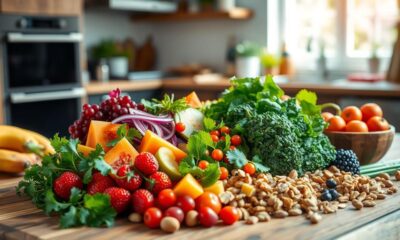
 Health and Wellness2 months ago
Health and Wellness2 months agoDoes Eating Raw Food Help You Lose Weight? Discover the Truth
-

 Raw Food Recipes2 months ago
Raw Food Recipes2 months agoHow Much Raw Food to Feed Your Puppy: Essential Tips
-
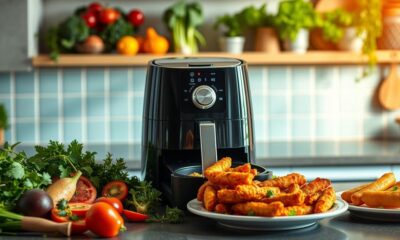
 Kitchen Essentials for Raw Food Preparation1 month ago
Kitchen Essentials for Raw Food Preparation1 month agoCan You Cook Raw Food in an Air Fryer? Discover the Possibilities
-

 Raw Food Recipes2 months ago
Raw Food Recipes2 months agoHow to Defrost Dog Raw Food Properly
-
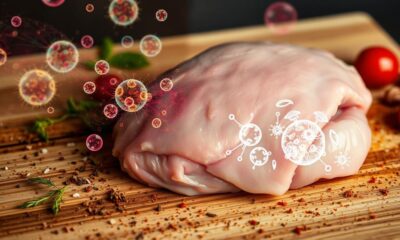
 Health and Wellness2 months ago
Health and Wellness2 months agoHow Long Does It Take Bacteria to Spread From Raw Food? Essential Info
-
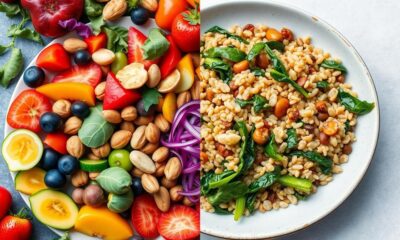
 Raw Food Recipes2 months ago
Raw Food Recipes2 months agoRaw Food Vs. Vegan: Which Diet Is Better?
-
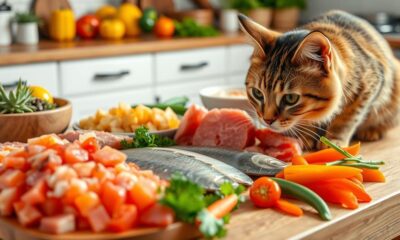
 Raw Food Recipes2 months ago
Raw Food Recipes2 months agoIs Raw Food Good for Cats? Find Out Here
-
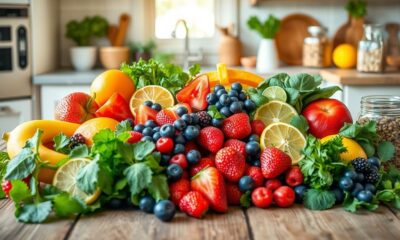
 Raw Food Recipes2 months ago
Raw Food Recipes2 months agoWhat Is the Raw Food Diet? A Comprehensive Overview


